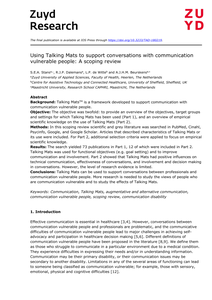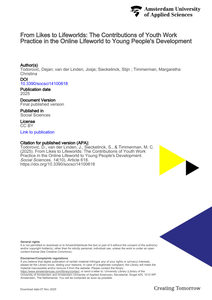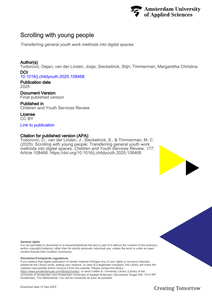Background: Talking Mats is a framework developed to support communication with communication vulnerable people. Objective: The objective was twofold: to provide an overview of the objectives, target groups and settings for which Talking Mats has been used (Part 1), and an overview of empirical scientific knowledge on the use of Talking Mats (Part 2). Methods: In this scoping review scientific and grey literature was searched in PubMed, Cinahl, Psycinfo, Google, and Google Scholar. Articles that described characteristics of Talking Mats or its use were included. For Part 2, additional selection criteria were applied to focus on empirical scientific knowledge. Results: The search yielded 73 publications in Part 1, 12 of which were included in Part 2. Talking Mats was used for functional objectives (e.g. goal setting) and to improve communication and involvement. Part 2 showed that Talking Mats had positive influences on technical communication, effectiveness of conversations, and involvement and decision making in conversations. However, the level of research evidence is limited. Conclusions: Talking Mats can be used to support conversations between professionals and communication vulnerable people. More research is needed to study the views of people who are communication vulnerable and to study the effects of Talking Mats.
DOCUMENT

Financially vulnerable consumers are often associated with suboptimal financial behaviors. Evaluated financial education programs so far show difficulties to effectively reach this target population. In our attempt to solve this problem, we built a behaviorally informed financial education program incorporating insights from both motivational and behavioral change theories. In a quasi-experimental field study among Dutch financially vulnerable people, we compared this program with both a control group and a traditional program group. In comparison with the control group, we found robust positive effects of the behaviorally informed program on financial skills and knowledge and self-reported financial behavior, but not on other outcomes. Additionally, we did not find evidence that the behaviorally informed program performed better than the traditional program. Finally, we discuss the findings and limitations of this study in light of the financial education literature and provide implications for policymaking and directions for future research.
MULTIFILE

As youth workers increasingly offer support and guidance within digital environments, the question arises as to what impact this support has on the (online) lives of young people. This paper explores the contribution of youth work practice in the online lifeworld on young peoples’ development, building on previous studies concerning youth work outcomes and the developmental needs of young people. A qualitative research design was employed, including digital diaries of youth workers and semi-structured interviews with both young people (N = 37) and youth workers (N = 25). The findings highlight the role of youth work in helping young people navigate social media; develop new skills, talents, and social connections; and increase awareness of online risks. Youth workers also support young people in coping with negative online experiences, including loneliness and mental health challenges. The contribution of online youth work is less visible in certain aspects of developmental needs, namely online safety and privacy, self-image, and assessing online information. This paper concludes by emphasising the need for further research into the long-term impact of youth work in the online lifeworld, particularly in light of rapid technological developments, the growing influence of artificial intelligence, and the increasing involvement of youth in digital forms of crime. The findings described in this study can form a base for future research to better understand the impact of these emerging issues on youth development and youth work practice, as well as to develop appropriate interventions.
DOCUMENT

This is the report on the situation in the Netherlands in the field of youth, young homeless people and unaccompanied minor aliens. The report describes risk factors for children and young people in relation to social exclusion and homelessness. This report forms the first part of the international comparative study ‘CSEYHP’. MOVISIE carries out this three-year study by order of the European Union. The cooperative partners are three universities in: England, the Czech Republic and Portugal. The objectives of ‘Combating Youth Homelessness’ are as follows: 1. to understand the life trajectories of different homeless youth populations in different national contexts; 2. to develop the concepts of risk and social exclusion in relation to the experience of young homeless people and to the reinsertion process; 3. to test how different methods of working contribute to the reinsertion process for young people; 4. to investigate the roles of and relationships between the young person, trusted adults, lead professionals, peer mentors and family members in the delivery of these programmes across all four countries. When preparing the national reports, the three partner countries the Czech Republic, England and Portugal use the same format as used in the Dutch report. Based on the four national reports, England will prepare a comparative report, in which the four national situations will be compared.
DOCUMENT

This report describes the results of the interviews that were held with professionals, policy makers, and researchers (working in the field of sexuality and/or residential and foster care) in three countries in order to answer the following question: ‘Which competencies (i.e. knowledge, skills, and attitude) do professionals working in care need in order to support healthy sexual development of young people in care? Chapter 3 describes the characteristics of young people growing up in care. Young people in care are generally more vulnerable than their peers living in normal families since they have grown up in unsafe family environments. They are often insecurely attached, have a lack of positive role models and positive sexual experiences, have not grown up with clear norms and values concerning sexuality, have low self-esteem and little knowledge about (healthy) sexuality. This set of characteristics makes them more likely to cross their own boundaries and that of others and to make unhealthy choices with regard to sexuality. Therefore, young people in care have special needs with regard to sexuality that professionals working in care should know about and act upon. To meet the special needs of young people in care, professionals should create a safe environment and be there for the young people, in order to make them feel safe and secure again. In addition, they should act as positive role models, set boundaries, help young people to gain self-confidence, and give them space to have positive sexual experiences and to discover their own norms and values. Professionals working in care should provide sexual education that supports young people in their knowledge, skills, and attitudes concerning sexual development and teaches them to make wise and responsible decisions for themselves. Professionals need to put aside prejudices about boys and girls and treat them equally. Chapter 4 describes opportunities to start a conversation with young people in care about sex, intimacy and relationship and what professionals should teach foster parents. Opportunities to start a conversation with young people in care are: 1. When one of the boys or girls spontaneously starts to talk about sexuality; 2. When young people have discussions about boyfriends, girlfriends, or sex. 3. When young people watch clips on social media in which sexuality plays a role. Important topics to discuss are: healthy sexual behaviour, relationships, wishes, boundaries, making your own decisions, changing behaviour after regretting something, norms and values, and social media. Professionals working in foster care should teach foster parents that: 1. It is their task to speak about this topic with their foster child; 2. They should already start talking about this topic to toddlers; 3. It is normal to have difficulties talking about this topic; 4. They should not only speak about the risks of sex but also about sexual pleasure, desire, love, and respect. Chapter 5 describes the personal characteristics and general competencies that professionals working in care should have in order to support the sexual development of young people in care. These are: 1. Have a high degree of self-awareness concerning their own limits, norms and values, and how this influences the way they work, 2. Know that norms and values are dependent on time and culture, 3. Treat children, young people, and parents with respect, 4. Have a good sense of professional judgment, 5. Feel responsible for one’s actions, 6. Have knowledge about trauma theory. Chapter 6 describes what organisations can do to support healthy sexual development of young people in care. Organisations can do the following on the organizational level: 1. Provide structural resources for training and reflection, 2. Create a safe environment and reflective culture, 3. Create diversity among team members, 4. Create access to experts on the topic of sexuality, 5. Pay attention to competencies during hiring processes, 6. Have organisational and institutional policies on the topic of sexuality, 7. Have organisational structures and tools to support relationships and conversations with young people.Chapter 7 describes factors at the professional, organisational, and societal level that may contribute to sexuality-related difficulties in both residential and foster care. Some of these factors are not specifically related to residential or foster care, such as low self-efficacy of professionals, insufficient time for reflection and negative media influences. Other factors are specifically related to residential care, such as having insufficient possibilities to experiment with sexuality (in residential care) and fear of foster parents being accused (in foster care).
DOCUMENT
This study explored what contributes to successful family foster care from the perspective of young people by asking them about their most positive memory of family foster care. Forty-four Dutch adolescents and young adults (aged 16–28) participated in this study and shared their most positive memory in a short interview. Their answers were qualitatively analyzed using reflexive thematic analysis, supplemented with an analysis of the structure of their memories. The thematic analysis resulted in the themes Belongingness, Receiving support, Normal family life, It is better than before, and Seeing yourself grow. The structural analysis showed that young people both shared memories related to specific events, as well as memories that portrayed how they felt for a prolonged period of time. In addition, young people were inclined to share negative memories alongside the positive memories. These results highlight that, in order to build a sense of belonging, it is important that of foster parents create a normal family environment for foster children and provide continuous support. Moreover, the negative memories shared by participants are discussed in light of a bias resulting from earlier traumatic experiences. Accepted Version. Published Version Article at Sage: https://doi.org/10.1177%2F1359104520978691
MULTIFILE

With the increasing significance of the online lifeworld in the lives of adolescents, youth work must adapt its methods to support young people’s personal development and social participation in this hybrid online space. To date, there is limited knowledge on how youth workers can effectively employ methodical actions in the online environment. This paper draws on established offline youth work methods to explore their potential transferability to the online context. The research question guiding this study is: How can offline youth work methods be used in the online lifeworld to support adolescents’ developmental needs? Using the Change Laboratory method, 26 youth workers from 14 youth work organisations in the Netherlands participated in this research. The findings suggest that while offline methods provide a valuable resource, they cannot be directly transferred to the online context without adaptation. Instead, they offer a framework for seven specific methodical actions that can be adapted or developed for the online context. They are: 1) Increasing online visibility and accessibility, 2) Orienting, 3) Signalling, 4) Making contact, 5) Building meaningful relationships, 6) Assessing needs, and 7) Providing support. By identifying these seven methodical actions which are crucial for addressing the developmental needs of adolescents online, this paper contributes to the growing body of knowledge on youth work in the online lifeworld.
DOCUMENT

This article offers an overview of 94 scientific studies (published between 2006 and 2022) to examine how young people (ages 10–36) define, consume, and evaluate news. Research on news and youth has exploded over the past decades, but what can we conclude from it, and how should journalism scholars move forward? The systematic literature review reveals that while young people remain interested in news, how they consume it has changed drastically. Social media platforms and algorithms now play a pivotal role in young people’s news consumption. Moreover, due to the overwhelming nature of today’s high-choice digital media landscape, youth engage both actively and passively with news, while sometimes exhibiting avoidance tendencies. The review also demonstrates how the impact of digitalization has reshaped young people’s ability to critically evaluate the credibility of news, often relying on social networks and technology platforms. The review concludes with a research agenda.
MULTIFILE

The online environment, where the boundaries between the domains of home, school, work, and leisure are blurred, poses new challenges for youth work practice. Due to limited research on this subject matter, the theoretical underpinnings of the online youth work practice are constrained. The fulfilment of youth work’s aims online, the position it can take in the online context, and its relation to its partners in the online lifeworld need a theoretical base. This paper seeks to analyse the role of youth work in the online lifeworld according to adolescents and youth work’s partners. The research was conducted in the Netherlands in collaboration with 14 youth work organisations. A qualitative research design was used: group conversations with young people and semi-structured interviews with youth work’s partners (i.e., parents, schools, informal networks, neighbourhood support teams, police, and municipal officials). The findings indicate that youth work in the online lifeworld, according to the respondents, is part of the general youth work practice, with a primary role of addressing the developmental needs of young people and creating new developmental opportunities. This role is expected to be fulfilled by engaging and connecting with young people in the online lifeworld and providing them instrumental, informational, socioemotional, and cognitive support. To do so, according to the partners, youth workers can make use of their vantage position in the online relationship with adolescents in order to access online information relevant for support and prudent prevention aimed at adolescents’ development. This vantage position may potentially encourage a collaboration between young people and partners, and between the online and offline youth work practice.
DOCUMENT

As people age, physiological changes affect their thermal perception, sensitivity and regulation. The ability to respond effectively to temperature fluctuations is compromised with physiological ageing, upsetting the homeostatic balance of health in some. As a result, older people can become vulnerable at extremes of thermal conditions in their environment. With population ageing worldwide, it is an imperative that there is a better understanding of older people’s thermal needs and preferences so that their comfort and wellbeing in their living environment can be optimised and healthy ageing achieved. However, the complex changes affecting the physiological layers of the individual during the ageing process, although largely inevitable, cannot be considered linear. They can happen in different stages, speeds and intensities throughout the ageing process, resulting in an older population with a great level of heterogeneity and risk. Therefore, predicting older people’s thermal requirements in an accurate way requires an in-depth investigation of their individual intrinsic differences. This paper discusses an exploratory study that collected data from 71 participants, aged 65 or above, from 57 households in South Australia, over a period of 9 months in 2019. The paper includes a preliminary evaluation of the effects of individual intrinsic characteristics such as sex, body composition, frailty and other factors, on thermal comfort. It is expected that understanding older people’s thermal comfort from the lens of these diversity-causing parameters could lead to the development of individualised thermal comfort models that fully capture the heterogeneity observed and respond directly to older people’s needs in an effective way. (article starts at page 13)
MULTIFILE